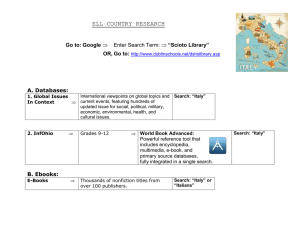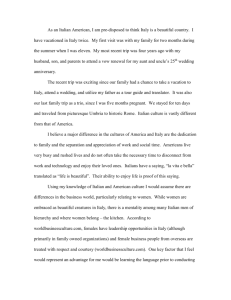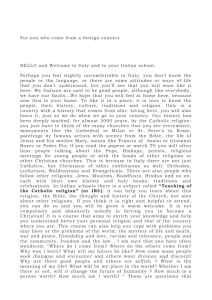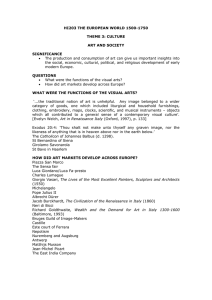Taxation of income of researchers in Italy
advertisement
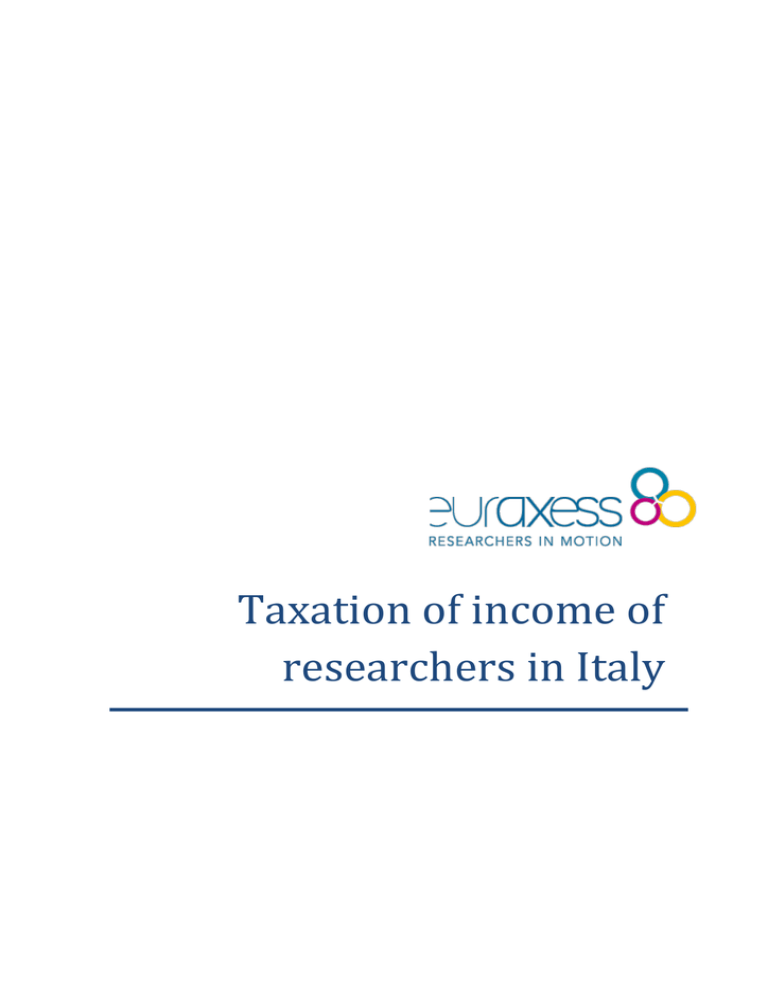
Taxation of income of researchers in Italy Acknowledgements: This Guide has been prepared by Valentina Mayer and produced within the project EURAXESS T.O.P. II – Network Call, managed by CRUI Foundation. This Guide is purely for information purposes and provides information on practical and administrative procedures in Italy. The information and indications that it contains do not replace official sources of information and provide no bases for claims or legitimate expectations of any kind. The contents of this Guide were last updated in September 2014. Information in this Guide should be always double-checked with host institutions or relevant official sources of information. © 2014 Fondazione CRUI Piazza Rondanini, 48, 00186 Roma Info: segreteria@fondazionecrui.it The book is published under Creative Commons - Attribution Non commercial - No Derivative Works 3.0 Information about http://creativecommons.org/licenses/by-nc-nd/3.0/ Content Introduction …….…..……………………………………………………..…......................................................................... 1 1. Tax system in Italy...……………………................................................................................................................. 1 1.1 Tax Identification Code………………………….................................................................................................................... 2 1.2 Income tax ................................................................................................................................................................................. 3 1.3 Employment ………………………………...………………………………………………............................................................ 4 1.4 Scholarship/grants and other income assimilated to employment ................................................................. 4 1.5 Independent Work/Self-Employment……………………………….……….…………………………………………….... 6 2. Tax rates ................................................................................................................................................................ 7 2.1. How the net tax is calculated ………………………………………………………………………………………………...… 7 3. Allowances for type of income ……………………………………………………………………………………………... 8 3.1. Dependent family members: reductions from IRPEF ………………………………………………………………... 9 3.2. Tax allowances …………………………………………………………………………………………………………………...……9 3.3. Specific cases …………………………………………………………………………………………………………………………...9 3.4. Health costs …………………………………………………………………………………………………..……………………….10 4. Tax filing and payment procedures …...………………………………………………………………….………….…11 4.1. Conventions against Double Taxation ………..……………………………………………………………………………12 4.2. General Principles …………………………………………………………...……………………………………………………..13 4.3. Researchers …………………………………………………………………………...……………………………………………....14 5. Useful links ………………………………………………………………………………………...………………………………..… 16 Introduction The following is a general summary of the Italian tax system with special reference to the taxation of income of mobile researchers in Italy. It may be used as source of information for both mobile researchers and their host institutions. It does not purport to be a complete analysis of all tax considerations that may be relevant to a researcher or his/her host institution and does not purport to deal with the tax consequences applicable to all categories of such researchers and institutions, some of which may be subject to special rules. This Guide is based upon the tax laws and/or practice at the date hereof, subject to any changes in law and/or practice occurring after such date, which could be made on a retroactive basis. Readers and prospective researchers should consult their tax advisers as to the overall tax consequences of their permanence, activity and/or residence in Italy. 1. Tax system in Italy The taxation system in Italy is administered by the Agenzia delle Entrate (Revenue Agency) which is the national legal authority for taxation and manages taxes at national level. Taxes are levied at national, regional and municipal level and can be grouped into two main categories: Direct taxes: IRPEF: Imposta sui Redditi delle Persone Fisiche (Personal Income Tax). It is applied on the following income: real estate income; capital gains; income from self-employment; income from employment; corporate income; other income; 1 IRES: Imposta sui Redditi delle Persone Giuridiche. It is the Corporation Tax levied on income of, among others, limited liability and joint-stock companies (in Italian “Srl – Società a responsabilità limitata” and “SpA – Società per Azioni” respectively); IRAP: Imposta Regionale sulle Attività Produttive. It is a quasi-income regional tax, which is levied on corporations and certain professionals, based on their assets value. Indirect taxes: • IVA (VAT) • Imposta di Registro (Registration Tax) • Imposte Ipotecarie e Catastali (Cadastral Taxes) • Imposta di Bollo (Stamp Duty) • Accise o Imposte di Fabbricazione e consumo (Excise Duties) Along with the main taxes, which are applied at national level, there are also local taxes (e.g. tax on municipal solid waste management). The Tax Year for individuals runs from 1st January to 31st December. 1.1 Tax Identification Code The tax identification code (Codice Fiscale, CF) is the citizen's fiscal identification number and it recognizes citizens when dealing with Italian Authorities and Administrations. It is required in Italy for all sorts of procedures (e.g. applying for a permit of stay, renting a flat, opening a bank account, applying for the National Health Service, applying for a fixed telephone line, etc.). The tax identification code is issued immediately and free of charge. EU/EEA citizen must bring a valid passport or another form of ID; non EU/EEA must bring the passport with a valid visa and a copy of it. The application can be filed with the local tax office of the Italian Inland Revenue (Agenzia delle Entrate). 2 1.2 Income tax Individual Income Tax (IRPEF) is governed by Italy’s Income Tax Consolidated Text (Testo Unico delle Imposte sui Redditi – TUIR). Individuals resident for tax purposes in Italy are subject to Individual Income Tax (IRPEF) on any income produced in Italy and abroad. Individuals non-resident for tax purposes in Italy are subject to IRPEF on their Italiansource income only. Residents are individuals who, for more than half of a tax period (i.e. more than 183 days in a calendar year): – Are recorded in the Register of Italian residents; or – Have their domicile or residence in Italian territory. Pursuant to the Italian Civil Code (art. 43), “residence” is the place in which individuals have their habitual abode, while “domicile” is the place in which their affairs are primarily conducted (the centre of their vital interests). In Italy, all workers are subject to taxation on any income realized in connection with their working activity, including benefits. The actual taxation regime varies according to the type (work contract, fellowship, research grants, etc.) and duration of the working arrangement, also depending on the worker’s status in Italy (resident or not). Basically, for tax purposes, there are three possibilities regarding how the working arrangements of a researcher could be qualified: employment, grant/scholarship and other arrangements assimilated to employment, or independent personal services. 3 1.3 Employment Employment income includes any compensation, either in cash or in kind, received during a tax period in connection with employment, including any payments received as shares, as acts of generosity or as reimbursement for expenses incurred in the production of the income. Benefits in kind are valued for tax purposes at the “normal value,” which is the fair market value as defined by the Italian tax code. An Italian employer, which qualifies as a withholding tax agent, must withhold income taxes monthly from payments of gross employment income, including benefits in kind. Non-residents are subject to tax on income from employment derived from services performed in Italy. 1.4 Scholarships/grants and other income assimilated to employment Scholarships granted to individuals fiscally resident in Italy are subject to taxation according to art. 50, par. 1, lett. C) of TUIR, which assimilates to employment income any sums paid as scholarship or grant, award or benefit for the purposes of study or vocational training, if the beneficiary is not bound by an employment contract to the payer. Some scholarships and research fellowships granted to individuals fiscally residents in Italy receive a special treatment and are exempted from taxation. In some limited cases, such exemption is granted also to individuals that are fiscally residents abroad (i.e. scholarships granted from the Italian Government to foreign citizens according to international agreements). 4 Italian law provides for a tax exemption for scholarships granted by University or institutions providing a university level of education for: • attending post-graduate course and specialization schools; • Phd courses; • post-Phd research activities; • attending post-graduate courses abroad.1 Taxation of scholarships different from those issued by the above-mentioned universities and received by non residents in Italy depends on the residence of the payer: - if the payer is resident in Italy, even in cases where the activity is carried out abroad, the scholarship is taxed in Italy (art. 23, paragraph 2, letter. b of TUIR); - if the payer is resident in a country other than Italy, the scholarship is taxed in the country of residence of the recipient, unless otherwise provided in the applicable Convention for avoidance of double taxation, if any. Income known as “deriving from a collaboration”, unless the activity is performed by an individual who is registered for value-added tax (VAT) purposes2, is considered as assimilated to employment income (e.g., the so-called lavoro a progetto, “contract work”, i.e. activity performed by individuals hired on a project basis). Generally speaking, EU fellowships and Assegni di ricerca (Research grants) are IRPEF and IRAP tax free. 5 1 2 Art. 6, par. 6, law 30.11.1989, n. 398. See the following section on Independent Work and Self-Employment. 1.5 Independent Work/Self-Employment Income from a collaboration that is not treated as employment income is generally qualified as self-employment income for tax purposes. This type of “self employment” arrangement is generally used in Italy by consultants (i.e. a free-lance professionals) or individual experts. Researchers establishing their tax residency in Italy and entering into an independent work arrangement with the relevant host institution in Italy, would be subject to tax on the income deriving from the related activity, which would be treated as selfemployment income for tax purposes. These researchers would be required to file for a VAT number in Italy and to annually file a tax return with the Italian Tax Office (Agenzia delle Entrate). A 20% withholding tax (advance payment, "ritenuta d'acconto" in Italian) would generally apply on income derived from services performed in Italy. In case of researchers not establishing their residency in Italy for tax purposes, who have an assignment for a job in Italy (e.g. for lecturing) and enter into an independent work arrangement with a host institution, the related income earned by such researchers would be subject to tax in Italy if the relevant activity is performed there. Non-residents are subject to tax on self-employment income derived from services performed in Italy. Non-residents are generally subject to a 30% withholding tax on such self-employment income and need not to file a tax return. With specific reference to professionals, taxable self-employment income generally results from the difference between compensation received during a tax period and the expenses incurred during the same period, subject to certain limits. Professional income is subject to VAT, personal income tax (IRPEF) and might also be subject to the regional quasi-income tax (IRAP). Bookkeeping is required. 6 2. Tax rates More in general, the personal income tax (IRPEF) is levied at progressive rates, up to 43% (as illustrated in the following table), plus an additional surcharge of up to 3.2% depending on the municipality of residence and an extraordinary surcharge — called “contributo di solidarietà” — of 3% on any income in excess of Euro 300,000, such extraordinary surcharge being deductible from taxable income and applicable for the 2014-2016 tax periods. Taxation of an individual's income in Italy is progressive. In other words, the higher the income, the higher the rate of tax payable. Taxable Income up to 15,000 euros more than 15,000 and up to 28,000 euros more than 28,000 and up to 55,000 euros more than 55,000 and up to 75,000 euros more than 75,000 euros Rate 23% 27% 38% 41% 43% IRPEF (Gross) 23% of income 3,450 + 27% on the part exceeding 15,000 euros 6,960 + 38% on the part exceeding 28,000 euros 17,220 + 41% on the part exceeding 55,000 euros 25,420 + 43% on the part exceeding 75,000 euros 2.1 How the net tax is calculated With respect to Italian-resident taxpayers, in order to establish the net taxable income (i.e. the first column of the table, above) it is sufficient to subtract any deductible item or costs (e.g. the items as indicated in Article 10 of TUIR, including medical expenses, social security contributions, house allowance or, for professional, costs related to the professional activity). 7 The effective personal income tax (IRPEF) charge (net tax) is determined by subtracting all recognized allowances (e.g., for dependent family members, for the type of income, for costs incurred) from the gross tax applied on the net income. The steps to follow to calculate the tax are: Total gross income – deductible costs = taxable income x rates = gross IRPEF Gross IRPEF – allowances (for dependent family members, for type of income, for costs incurred, others) = net IRPEF It should be noted that the gross tax is determined by applying IRPEF rates to the overall income earned by a taxpayer resident in Italy for tax purposes, net of the above-mentioned allowed deductions. 3. Allowances for type of income The progressive nature of the mechanism for calculating IRPEF is guaranteed, as well as by the rates and the income brackets, by a system of tax allowances that are different according to the type of income received (income from employment, pension, income from self-employment, commercial income, and so forth). As for the allowances for dependent family members, those, according to the type of income, decrease as the income increases. When calculating the effective amounts of tax, the parameter referred to is not the specific income category (for example the amount of employment income, the amount of self-employment income) but rather the taxpayer’s total income. Allowances for employees and pensioners need to be adjusted to the period of employment or of pension (expressed in days). The others are applied independently from the period a person has been employed throughout the year. 8 3.1. Dependent family members: reductions from IRPEF Taxpayers with dependent family members benefit, instead of the previous income deductions, from a tax deduction, based on the amounts established by article 12 of the TUIR. 3.2. Tax allowances IRPEF reductions are provided for costs with a particular social relevance, such as those paid for health reasons, for interests on house mortgages, or for education. Depending on the case, these reductions are obtained by submitting the income tax return and can be claimed in two different ways: the costs sustained can be “deducted” from the income produced or they can qualify as a right to a 19% tax allowance or to a flat rate allowance or tax deduction. In order to be considered in the tax return, the expenses must have been sustained during the year for which the return is filed, even if the relative services date to the preceding years (i.e., the “cash basis” principle applies). The costs must be, normally, sustained by the declaring party, in his/her interest. 3.3. Specific cases Dependent relatives. For medical expenses, for costs relative to insurance and voluntary contributions, as well as for those paid to follow secondary or university education courses, the allowance is generally conceded even when the cost is sustained by dependent relatives. Sons or daughters. When the cost is paid for sons or daughters, the allowance is awarded to the parent whose name the receipt is in. If this document is in the name of the son or daughter, the costs must be divided by 50/50 between the two parents. If the parents intend to divide the cost differently, they must record the new percentage agreed on the receipt. Of course, if one of the two spouses is fiscally dependent on the other, the latter can always consider the entire cost sustained in order to calculate the allowance. 9 Refunds. The allowance is normally recognized only for costs that have effectively remained an expense of the taxpayer. In the case of refunds received from social security and public health authorities (for example refunds from the Health Services or from company support funds, which have not received payments adding to the employee’s income from the taxpayer or the employer) medical expenses cannot be considered to have “remained an expense of the taxpayer” and, therefore, the taxpayer has no right to the allowance. On the other hand, the allowance is recognized for sums paid out by insurance companies, if the premium paid is not subject to tax cuts (for example, health insurances). 3.4. Health costs Health costs, of any type (doctor’s fees, general costs, specialist’s fees, surgery costs, pharmaceutical costs, etc.) qualify for a 19% tax allowance. Taxpayers must add all health-related expenses incurred and deduct the allowance: the allowance owed is 19% of the resulting sum. Of course, if the costs incurred during the year are not higher than the allowance, no allowance is owed. The allowance is applied to the entire cost (without subtracting any sum) if this covers the means necessary to accompany, move and lift disabled people, and the purchase of technical equipment and software needed to help them live self-sufficiently and increase their integration. In calculating medical costs that qualify for the 19% allowance, expenses covered by insurance companies following contracts agreed by the taxpayer or his/her employer may be included (the relative insurance premiums paid by employers are not deductible and cannot in fact be deducted by the taxpayer), as well as the part of expenses refunded due to health care subsidies that have contributed to form the income. 10 4. Tax filing and payment procedures Professional and qualified assistance for family members applications, household income (ISEE), family benefits, taxation and tax returns, etc. is provided by authorised offices called CAF (Centro Assistenza Fiscale - Centre for Fiscal Assistance) and PATRONATI which can give you professional support. In general a tax return (Dichiarazione dei redditi) is due for workers each year by the end of April (or end of May in case you address a CAF or a qualified professional for assistance). Employees, workers “assimilated to employees” and pensioners are supposed to submit this tax return and claim their income and tax deductible expenses (medical and certain educational expenses; health insurance; etc.) with their employers or entity paying their pensions , using the 730 Form (Modulo 730). Any amount due would be paid out or deducted with the July salary. A failure to make a filing is subject to a penalty ranging from €258 to €1,032 (if no income tax is due) or ranging from 120% to 240% of the tax due, plus interest (if a tax liability arises). If the tax return is filed within up to 90 days after the due date, under a special procedure to reduce penalties called “ravvedimento operoso”, the ordinary penalties mentioned above may be reduced by 1/10. Income tax must be paid by 16 June for income earned in the preceding calendar year. Advance tax payments must be made, equal to 99% of the preceding year’s tax liability. Self-employees and professionals are required to file their tax returns directly with the Italian tax authorities (Agenzia delle Entrate) by September 30 of each year and pay any taxes due accordingly. Omission to file the due tax return and pay such taxes would result in the same penalties indicated above. 11 4.1. Conventions against Double Taxation A foreign researcher, before starting the relationship with his/her hosting institution in Italy is normally resident in a country other than Italy. In tax law this will result in the application of the rules for non-residents and the international conventions for the avoidance of double taxation. Italy has entered into double tax treaties with the following countries: Albania Algeria Argentina Armenia Australia Austria Azerbaijan Bangladesh Belarus Belgium Brazil Bulgaria Canada China Côte d’Ivoire Croatia Cyprus Czech Republic Denmark Ecuador Egypt Estonia Ethiopia Finland France Georgia Germany Ghana Greece Hungary Iceland India Indonesia Ireland Israel Japan Jordan Kazakhstan Kenya (a) Korea (South) Kuwait Latvia Lebanon Lithuania Luxembourg Macedonia Malaysia Malta Mauritius Mexico Moldova Mongolia Morocco Mozambique Netherlands New Zealand Norway Oman Pakistan Philippines Poland Portugal Qatar Romania Russian Federation Saudi Arabia Senegal Singapore Slovak Republic Slovenia South Africa Spain Sri Lanka Sweden Switzerland Syria Tanzania Thailand Trinidad and Tobago Tunisia Turkey Uganda Ukraine United Arab Emirates United Kingdom United States Russian Federation (b) Uzbekistan Venezuela Vietnam Yugoslavia(former) (c) Zambia (a) The treaty has been ratified, but is not yet in force. (b) Italy honors the Russian Federation treaty with respect to the republics of the Commonwealth of Independent States. (c) This treaty applies to Bosnia-Herzegovina, Croatia, Montenegro and Serbia. 12 4.2. General Principles The above treaties establish the range of the power to set taxes of the two States, thus regulating the tax processing of each category of income. Depending on the categories involved, these agreements provide the possibility for both States to tax the same income (concurrent taxation) or, sometimes, the exclusive taxation by one State only. The rule established for the main categories of income states that, barring some exceptions, the beneficiary pays tax in the country of fiscal residence, but also allows the State where the subject making the payment (source country) is resident to levy taxes thereon, but within well-defined limits. These limits have fixed rates which, in most cases, are lower than those in force on a national level. The rules established by the agreement provide, upon request by the taxpayer, the right to be refunded by the source country of any paid tax, in case it exceeds the amount established by the agreement, or, sometimes, the right to have the expected benefit immediately applied, already when the tax is deducted. The competent authorities of the two countries can agree on specific ways of refund or of direct application of the agreement, consisting in the adoption of specific forms. The forms so far agreed concern the application of conventional reductions for the most important categories of income: dividends, interest and royalties. The forms, formulated in two or more copies, along with a copy for the beneficiary, include the statements issued by the beneficiary according to the requirements of the agreement. They also have a part concerning the attestation of residence, to be filled in by the tax authorities of the country of residence. On the basis of the existing law, there is no specific obligation to use the agreed forms in place of an informal application for refund. The forms, deriving from a specific understanding between the two contracting States, aim at avoiding problems of an operative nature and thus facilitate those entitled. Furthermore there are forms drawn up unilaterally by the foreign tax authorities which can equally be used to facilitate operations. 13 4.3. Researchers Foreign researchers who are resident in a country that has signed a convention against double taxation with, are generally subject to tax only in their country of residence, subject to certain conditions. Usually, these conditions include the following: - a time limit: for the exemption to apply, the researcher can only be carrying out his/her activity in Italy for a limited amount of time (usually two years). - title or other qualification: certain conventions also require the researcher to be a "teacher or professor" in his/her country of residence. If these conditions are fulfilled, the researcher would not be subject to tax in Italy on the income paid in connection with the research activities carried out in Italy. However, for the correct application of the Conventions, it is necessary to first understand and check the conditions of the exemption, and then acquire the supporting evidence. Please take note of the following issues for the correct application of the Conventions: 1) The contractual relationship with the non-resident should be correctly defined, in order to verify if the type of income is considered taxable or not by the agreement between Italy and the State of residence of the taxpayer. 2) The application for the direct application of the Convention by non-resident subjects in Italy must be filed to the Italian withholding agent (employer) in case of deduction at source. The Italian Ministry of Finance stated in fact that the withholding agents have the right, under their responsibility, to directly apply the exemption or the lower tax rates provided for in the Conventions in force between Italy and the State of residence of the recipient of the income. 3) The non-resident in Italy may also submit a request for refund by form if available, or by informal claim to Agenzia delle Entrate (Centro Operativo di Pescara - Pescara Operational Centre), within the limitation period of 48 months from the date of payment of the tax. 14 4) When requesting the direct application of the exemption, it is important to refer to the current text of the Convention, instead of applying standard definitions. 3 5) Once you have identified the conditions of the exemption, you will need to acquire the supporting evidence. To this end, a request for application of the Convention should be prepared, with a declaration from the applicant that the conditions for the application of the Convention are fulfilled (for example, in the case of self-employment, that he/she does not have a fixed base in the Italian territory). It is worth dwelling on the application of the Convention. Please note that even if the applicable Convention provides for the exemption of the income earned by a taxpayer and/or non-resident individual in Italy, in certain cases (especially if the taxpayer does not provide sufficient evidence of his/her exempt status), such income might still be subject to tax in Italy. In these circumstances, the non-resident person would be forced to file for a refund of the withholding tax eventually applied in Italy, with the complications and difficulties that would come with it. The consultation with an expert or professional on tax issues is recommended, due to the complexity of the matter. The Conventions are modeled, in most cases, to the OECD model, but this has been amended several times and it is not mandatory, because States remain free to regulate this matter on the basis of their mutual agreement. It should therefore be read carefully the text of the convention that will apply, and in particular, whether it provides the non-taxation of certain income produced in Italy by nonresident. If this is not the case, taxation will be applied in accordance with the general rules. 15 3 5. Useful links For further information about taxation in Italy: Tax Revenue Agency website (English) http://www1.agenziaentrate.gov.it/inglese/ List and Texts of the Conventions against double Taxation (Italian) http://www.finanze.it/export/finanze/Per_conoscere_il_fisco/fiscalita_Comunitaria_ Internazionale/convenzioni_e_accordi/convenzioni_stipulate.htm Your Europe – Taxation (English) http://europa.eu/youreurope/citizens/education/research/tax/index_en.htm 16
